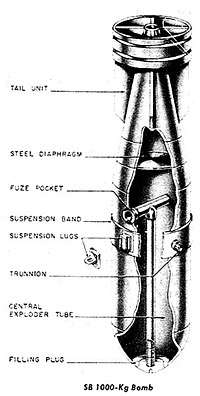SB 1000
The SB 1000 (Spezialbombe) was a luftmine or aerial mine in English used by the Luftwaffe during World War II.
| SB 1000 | |
|---|---|
 Schematic of SB 1000 components. | |
| Type | Luftmine |
| Place of origin | |
| Service history | |
| Used by | Luftwaffe |
| Wars | World War II |
| Specifications | |
| Mass | 1,000 kg (2,200 lb) |
| Length | 2.64 m (8 ft 8 in) |
| Diameter | 660 mm (26 in) |
| Warhead | RDX and Trialen |
| Warhead weight | 735 kg (1,620 lb)[1] |
History
The SB series of bombs were designed to be high-capacity bombs that were intended to create the largest lateral blast effect on detonation. This was in contrast to most other German bombs, which were either armor-piercing, cluster bombs, fragmentation or incendiaries. Since the SB series wasn't designed to pierce armor or to create fragments, the casing of the series were very light and the ratio of charge to weight was high at 73%, while the majority of general-purpose bombs were up to 50%.[1]
Design
The SB 1000 had a welded sheet metal body with either a drawn or welded steel nose piece. The nose piece was threaded and was streamlined to reduce drag while the bomb was attached to the aircraft. The SB 1000 had no base plate and was filled through the nose with a central exploder tube which ran through the center of the bomb from the fuze pocket to the nose. The tail of the SB 1000 was constructed of drawn steel and had four fins inside a circular strut. The SB 1000 was suspended horizontally by an H-type lug or trunnions if carried by dive bombers. The SB 1000 was filled with a mixture of RDX biscuits within a Trialen 105 matrix. Trialen 105 was a mixture of 15% RDX, 70% TNT and 15% aluminum powder. Due to its thin case and powerful explosives, the SB 1000 was vulnerable to enemy gunfire.[1]
References
- United States War Office (1953). German explosive ordnance : (bombs, fuzes, rockets, land mines, grenades and igniters). United States Government Printing Office. OCLC 713755660.